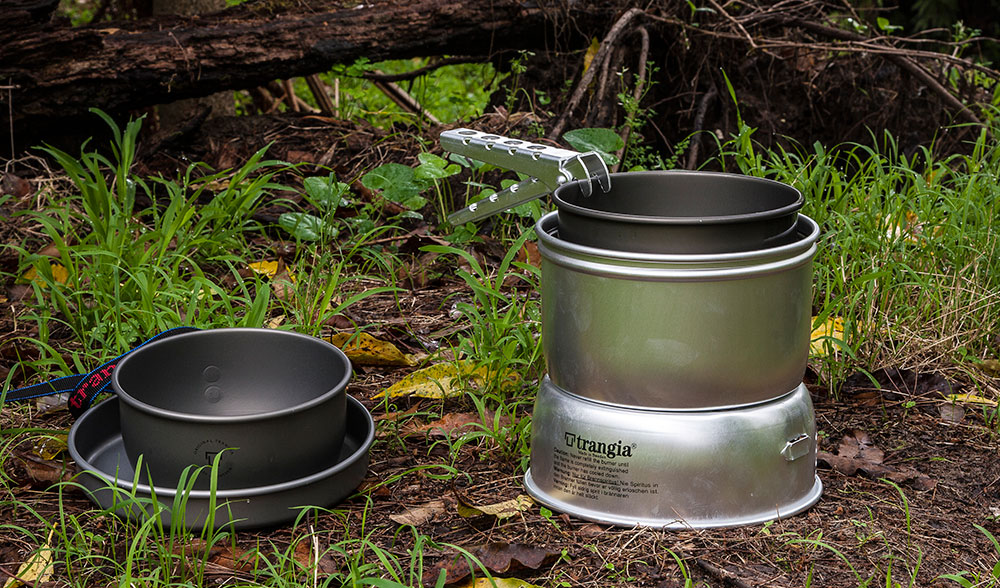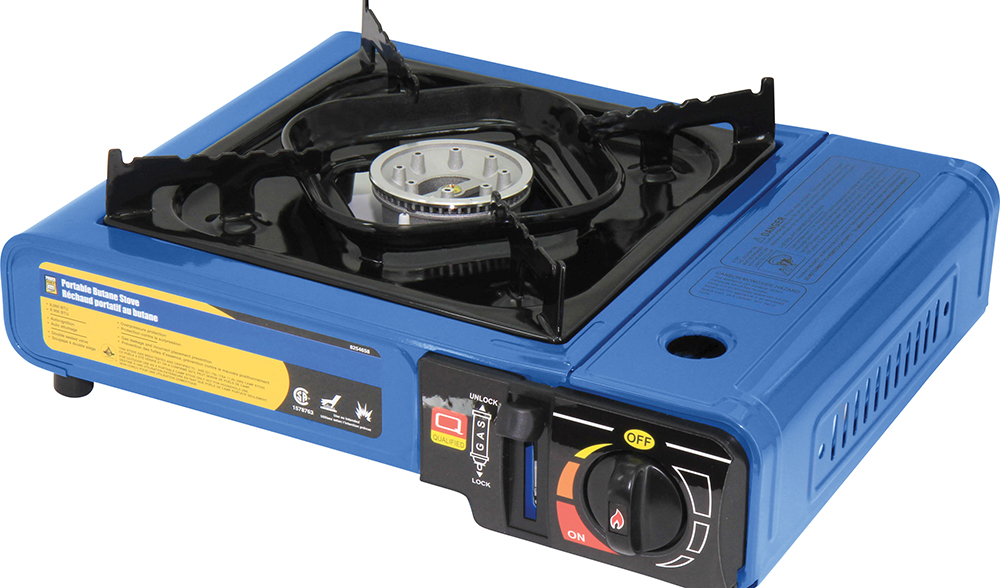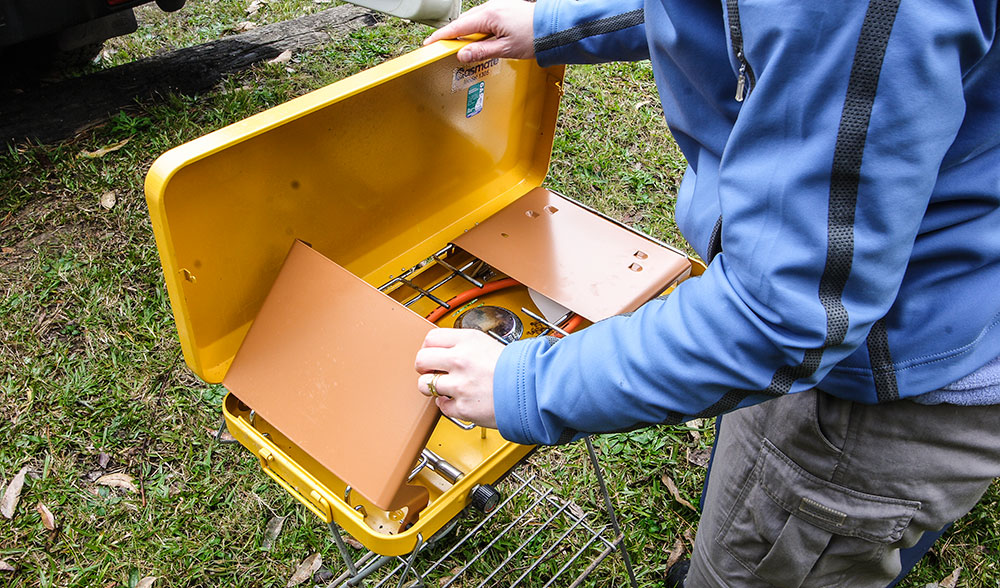No matter what outdoor activity you’re into, if you’re out in the bush for more than a day you’ll eventually need to cook something to eat. While making fire is one option, it’s not always practical, advisable, possible or even legal. What you’ll need then is a camp stove.
Choosing the right stove to suit your needs will depend on a variety of factors, including where you’re travelling, how you’re getting there and how many people will be in your party. In the interests of simplicity, we’ll break this guide down into three distinct categories: lunchbox-style butane stoves; traditional gas-bottle fuelled stoves; and compact hiking stoves.





LUNCH BOX COOKER
One of the most popular camp stoves is the single burner butane variety, sometimes referred to as a lunch-box style cooker. With prices starting from less than $20, and features such as a convenient disposable butane cartridge, Piezo ignition and a compact plastic carry case for easy transportation, it’s little wonder these things can be found in just about every campsite around the country. And you can buy them just about anywhere too, including Woolies, Coles, specialist camping stores, disposal stores and, of course, online.
After several recent incidents resulting in injuries and even a death in Australia, however, many of these single burner butane camp stoves were withdrawn from sale and several recall notices issued. The main issue with problematic models was found to be a faulty safety-release mechanism, which is designed to eject the butane canister when it overheats. As the canister is located right alongside the cooking area, overheating of the canister is not uncommon, and can be caused by using an oversize pan which can reflect heat back towards the canister, incorrect assembly of the appliance, placing the cooker on top of another heat source, or leaving the cooker in a hot vehicle with the canister still attached.
If you buy one of these single-burner butane camp stoves, make sure it is a compliant model not affected by any safety recall.
Positives
- Cheap
- Gas bottles can be refilled
- High heat output (11,000 BTU/h)
Negatives
- Separate gas bottle required
- Need to carry spare gas bottle
- Best on flat cooking surface
LPG STOVES
If you have the space, a bottle-gas stove is a great way to cook, and there’s a huge range of models and sizes available, from single-burner units to four-burner set-ups that would just about rival your home barbecue for cooking performance.
The gas bottles are filled with LPG (Liquified Petroleum Gas), which is a combination of butane and propane, and there are a variety of reason to opt for such a fuel: the bottles are refillable; it’s a cheap fuel; it can be purchased at most service stations around the country; gas bottles range in size from 1kg to 9kg; LPG offers loads of cooking power; it’s a proven and robust set-up.
The gas bottles themselves have a lifespan of 10 years, after which they must be inspected and re-stamped, or replaced altogether. Depending on the stove type, the gas cylinder is either connected directly or via a governor.
The simplest and most portable gas stoves consist solely of a burner that attaches directly to the top of the gas bottle, and these are usually suited to bottles with a 3/8-inch connector. Other direct-connect designs offer large cooking plates and posts, which raise the cooking surface to a more convenient height.
A popular and relatively compact set-up is the traditional two-burner gas stove. This design has been around for many years; it packs away into a small, self-contained briefcase-size unit and when unfolded it has legs and the lid and side panels act as wind buffers. Many modern units feature Piezo ignition and stainless steel construction, and the two-burner arrangement is convenient for cooking meals such as pastas, where you can boil the pasta on one side and cook/heat the sauce on the other. You can pick up a reputable brand stove such as a Primus, Coleman or Gasmate for between $45-$100, plus the gas bottle.
If you’re cooking for a family you’ll probably want to upgrade to a four-burner gas stove; a good example is the Companion Quad Burner Wok Cooker which features two large and two small burners, Piezo ignition, a stainless steel body and brass burner inserts. It also has a built-in regulator for direct connection to gas bottles, and can be bought for around $240.
If you opt for a gas bottle set-up, there are a variety of other outdoor accessories that can be powered by the same fuel source, including camp lighting and three-way portable fridge/ freezers. If you have the space, it’s always advisable to carry a spare gas bottle with you – after all, they only ever run out of gas when you’re using them.
Positives
- Cheap
- Easy to use
- Refills readily available
Negatives
- Low heat output (7500 BTU/h)
- Lack of windshield
- Inefficient
CANISTER STOVES
The simplest and smallest of the canister stoves simply consist a burner that screws directly into the top of a disposable canister. Called upright stoves, some of these burners will have a pin that pierces directly through the top of the canister, or a standardised threaded Lindal valve that’s used by many canister manufacturers. The piercable variety canisters are the cheapest and can be found just about anywhere in the world, but once attached to the stove they can’t be disconnected until the canister is empty, presenting a possible fire hazard if there’s a leak when the set-up is stored in your car.
A variety of fuels are used in disposable canisters including propane, butane and Isobutane, and usually a mixture of these fuels. In upright stoves, the fuels must be in a vaporised state to drive the vapour out the top of the canister; if the ambient temperature drops below the fuel’s boiling point, it will become a liquid and the stove will not work. Butane boils at -0.5C, propane boils at -42C, while a mixture of these two fuels will boil somewhere within this range depending on the ratio of the blend. So if you’re going to use your stove in extremely cold conditions, it’s important that your canister has the right fuel blend to operate in said conditions.
Low-profile canister stoves have a burner that’s connected to the canister via a fuel hose. These offer better cold-weather performance than the upright-style stoves as the canister can be inverted to access the fuel inside. Low-profile canister stoves can also be used with a windshield to improve performance, whereas this is not advisable with upright models as excessive heat near the canister lead to an explosion.
There are also several integrated stove systems on the market in which the canister stove is paired with a cooking pot. Accessories such as canister stabiliser legs are also available.
Positivies
- Convenient
- Fast
Negatives
- Canisters don’t work well in extreme cold
- More expensive than LPG
- Not refillable
NATURAL FUEL STOVES
There are a number of natural fuel stoves on the market that will run on anything from twigs to alcohol. The main advantage of a stove that burns twigs and sticks is that you’re able to source fuel on-site, so you don’t have to carry it with you. On the downside, finding dry fuel can be a problem in wet weather.
The main advantage of an alcohol-fuelled stove is that it’s very simple with no moving parts, but it won’t burn as hot as a canister or liquid-fuel stove, so it will take longer to boil a pot of water.
Another alternative is a solid fuel tablet stove, which burns Esbit tablets (waxy, solid rectangular tablets made from hexamine). These are extremely simple devices and the fuel is light, cheap and easy to transport, but they are not very effective in windy conditions.
Positives
- Simple
- Fuel can be sourced on-site
- Fuel tablets can be used
Negatives
- Slow cooking
- Dry fuel not always available
- Ineffective in windy conditions
LIQUID FUEL STOVES
For very cold conditions where a canister stove will not operate you’ll need a liquid-fuel stove, as it will operate in extremely cold conditions. Most liquid-fuel stoves will burn a variety of easily sourced fuels and refillable tanks means there’s no need to carry additional canisters.
Liquid fuel stoves are pretty simple, too, consisting of a tank, a pump, a fuel line, a valve and a burner. The tank holds the fuel, the pump is used to create enough pressure to force the fuel down the fuel line, the valve controls the fuel flow and the burner is where the fuel and air mix and burn.
All liquid stoves will burn white gas, which is essentially a very pure form petroleum (gasoline), while many will also burn other petroleum distillates including kerosene, diesel, ULP and even jet fuel, meaning you can source cheap fuel just about anywhere in the world.
Features to look for include rapid boiling capability and simmering functions, depending on whether you simply want to boil water fast for rehydration packs or whether you want to cook ‘proper’ meals.
Positives
- Use a variety of fuels
- No need to carry many canisters
- Cold condition performance
Negatives
- Heavier than canister stoves
- Require regular maintenance
- Need priming





